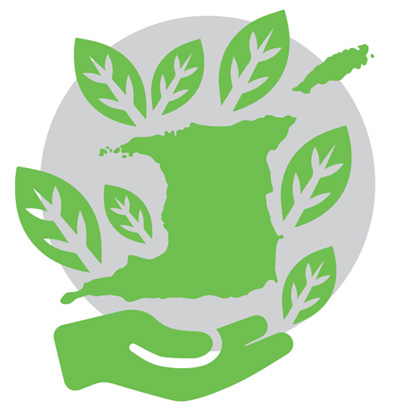 |
 |
 |
|
September 2018
|
As cited in the new Protected Area Systems Plan (TTPASP), “Trinidad and Tobago is among the most biologically diverse countries in the Caribbean with over 3639 species of plants (including 2407 native species) (Baksh-Comeau et al. 2016), 600 species of terrestrial vertebrates and 1100 species of recorded invertebrates (Starr 2010).” It is this diversity that the Plan seeks to safeguard. The 2018 TTPASP is to be presented this month. It represents five years of fieldwork, consultations with communities, and distilling the native knowledge and surveys – historical and contemporary – of specialist scientific and interest groups. The thoroughness and specificity with which ecosystems on land and in the marine areas have been considered is laudable. The result is a document that should be required reading for students of ecology from secondary school and beyond. Published, it may be a reference collection for every Trinbagonian wanting information on the precious resources of our native isles. Furthermore, it takes into account the up-to-date thinking and practice of the global Convention on Biological Diversity. Most importantly, the 2018 TTPASP is not set in stone. Building on the 1980 plan (Thelen and Faizool), it provides a realistic and sensitive roadmap for the way forward. It is intended to be a living document: as initiatives are implemented, levels of protection may be changed, and areas under conservation may be modified or expanded. Of greatest significance perhaps, are the recommendations for managing the Open-Ocean Waters and Deep-Sea (OOWDS) areas, especially in the country’s exclusive economic zone which extends into the deep Atlantic; much of which has not been explored. Recent forays have revealed life in hot water vents and methane seeps: “Many of these ecosystems, for example, the deep marine ecosystems within Trinidad and Tobago’s exclusive economic zone (EEZ), remain areas of active biological exploration, while simultaneously being important areas of economic development (Amon, et al. 2017).” For consideration too is the Northeast Tobago Marine Protected Area, some 53,000 hectares of coastal and marine ecosystem comprising “a complex seascape of offshore islands, coral reefs, sponge reefs and sandy beaches important for recreational, fishing and ecotourism use.” The Plan was commissioned by the Government of the Republic of Trinidad and Tobago in 2013 and was developed and completed through partners, the European Union, Food and Agriculture Organisation of the United Nations (FAO) and the Global Environmental Fund (GEF). It aims to bring Trinidad and Tobago in compliance with the Aichi targets under the Convention on Biological Diversity (CBD). At the 10th meeting (2010) on Biological Diversity in Aichi, Nagoya Japan, the countries/parties agreed on strategic biodiversity targets to be achieved by 2020; these include, among others, the strategy “to improve the status of biodiversity by safeguarding ecosystems, species and genetic diversity.” The TTPASP includes recommendations for implementation, management and opportunities in education, employment and entrepreneurship. Like the battle against climate change, protecting natural areas is an investment in future wealth and well-being. It requires individual buy-in to a collective benefit. Natural Areas to be Considered for Protection“The new system plan identifies 136 PNAs (protected natural areas)across Trinidad and Tobago. Of these, 92 are terrestrial/freshwater (79 in Trinidad, 13 in Tobago), 40 are coastal/marine (18 in Trinidad, 22 in Tobago) and four are deep-sea marine areas. In total, approximately 1933 km2 (1866 km2 in Trinidad, 67 km2 in Tobago) of the country’s land mass are covered by terrestrial/freshwater PNAs. The coastal and marine areas are approximately 580 km2 (14 km2 in Trinidad and 566 km2 in Tobago) in size. Open-ocean waters and deep-sea marine areas cover 15,600km2 of Trinidad and Tobago’s Exclusive Economic Zone. Thus, 38% of the country’s land mass is protected by terrestrial/freshwater PNAs and coastal, marine and OOWDS PNAs protect 22% of Trinidad and Tobago’s EEZ.” (Extract from National Protected Area Systems Plan for Trinidad and Tobago, 2018) |


 Two years ago, an oilbird had to be rescued from a ledge on one of the upper storeys of the Twin Towers in Port of Spain. Yellow-headed green parrots used to perch and peck at the glass windows of another high-rise office building on the Savannah. In any of the residential valleys off the Northern Range, iguanas, agoutis and manicous regularly walk through backyards. And birds – native and visiting – nest in many urban gardens. The wild, it seems, is never far from where we live in Trinidad or Tobago.
Two years ago, an oilbird had to be rescued from a ledge on one of the upper storeys of the Twin Towers in Port of Spain. Yellow-headed green parrots used to perch and peck at the glass windows of another high-rise office building on the Savannah. In any of the residential valleys off the Northern Range, iguanas, agoutis and manicous regularly walk through backyards. And birds – native and visiting – nest in many urban gardens. The wild, it seems, is never far from where we live in Trinidad or Tobago.